Growing Stock Volume Retrieval from Single and Multi-Frequency Radar Backscatter
Abstract
:1. Introduction
2. Materials
2.1. Study Area and In Situ Data
2.2. Earth Observation Data
3. Methods
3.1. SAR Data Processing and Extraction
3.2. Growing Stock Volume Retrieval
3.3. GSV Retrieval Accuracy
3.4. Local vs. Global GSV Retrieval
4. Results and Discussions
4.1. Pixel-Wise GSV Estimation
4.2. Grid Based GSV Accuracy
4.3. Comparison to Global Products
5. Conclusions
Author Contributions
Funding
Data Availability Statement
Acknowledgments
Conflicts of Interest
Appendix A
| Independent Variables | RMSE | RelRMSE | Bias | r | Independent Variables | RMSE | RelRMSE | Bias | r |
|---|---|---|---|---|---|---|---|---|---|
| Single polarized models based on L-band data | Single polarized models based on C-band data | ||||||||
| L-HH | 282.9 | 66.3 | 3.1 | 0.14 | Ca-VV | 275.0 | 63.9 | −2.7 | 0.21 |
| Cd-VV | 277.5 | 64.6 | −2.9 | 0.19 | |||||
| L-HH, L-HHsd | 264.0 | 61.6 | −1.1 | 0.24 | Cd-VH, Cd-VHsd | 265.0 | 62.7 | −2.6 | 0.26 |
| Ca-VV, Ca-VVsd | 262.6 | 62.4 | −0.5 | 0.27 | |||||
| Cd-VV, Cd-VVsd | 264.6 | 62.8 | 0.36 | 0.26 | |||||
| L-HV, L-HVsd, Ft | 244.0 | 57.1 | 0.02 | 0.41 | Ca-VH, Ca-VHsd, Ft | 249.0 | 59.2 | 2.1 | 0.38 |
| L-HH, L-HHsd, Ft | 244.2 | 57.6 | 4.3 | 0.40 | Cd-VH, Cd-VHsd, Ft | 253.7 | 59.8 | −3.8 | 0.36 |
| Ca-VV, Ca-VVsd, Ft | 248.7 | 59.3 | 1.0 | 0.39 | |||||
| Cd-VV, Cd-VVsd, Ft | 249.9 | 59.5 | 3.1 | 0.37 | |||||
| L-HV, L-HVsd, LIA | 246.4 | 57.6 | 1.5 | 0.40 | Ca-VH, Ca-VHsd, LIA | 256.8 | 60.9 | −2.0 | 0.31 |
| L-HH, L-HHsd, LIA | 250.7 | 58.8 | 0.75 | 0.37 | Cd-VH, Cd-VHsd, LIA | 260.0 | 61.2 | −3.5 | 0.32 |
| Ca-VV, Ca-VVsd, LIA | 257.4 | 61.3 | 1.7 | 0.30 | |||||
| Cd-VV, Cd-VVsd, LIA | 261.1 | 61.7 | −3.5 | 0.30 | |||||
| L-HV, L-HVsd, LIA, Ft | 240.3 | 56.2 | −0.6 | 0.44 | Ca-VH, Ca-VHsd, LIA, Ft | 248.4 | 59.3 | 2.4 | 0.38 |
| L-HH, L-HHsd, LIA, Ft | 237.7 | 55.9 | 3.4 | 0.45 | Cd-VH, Cd-VHsd, LIA, Ft | 252.5 | 59.7 | −0.3 | 0.37 |
| Ca-VV, Ca-VVsd, LIA, Ft | 249.5 | 59.5 | 3.7 | 0.38 | |||||
| Cd-VV, Cd-VVsd, LIA, Ft | 249.8 | 58.6 | −5.4 | 0.39 | |||||
| Multi-polarized models based on L-band data | Multi-polarized models based on C-band data | ||||||||
| L-HV, L-HH | 253.0 | 58.9 | 0.2 | 0.36 | Ca-VV, Ca-VH | 267.0 | 62.4 | 0.7 | 0.25 |
| Cd-VV, C-VH | 262.0 | 61.1 | 0.2 | 0.27 | |||||
| L-HV, L-HH, L-HH/HV | 251.9 | 59.1 | 2.5 | 0.39 | Ca-VV, Ca-VH, Ca-VV/VH | 264.8 | 61.8 | 3.3 | 0.24 |
| Cd-VV, Cd-VH, Cd-VV/VH | 260.6 | 61.2 | 2.6 | 0.28 | |||||
| L-HV, L-HH, L-HH/HV, Ft | 249.2 | 58.0 | 0.42 | 0.40 | Ca-VV, Ca-VH, Ca-VV/VH, Ft | 253.1 | 59.0 | −1.0 | 0.35 |
| Cd-VV, Cd-VH, Cd-VV/VH Ft | 248.8 | 58.0 | −1.9 | 0.38 | |||||
| L-HV, L-HH, L-HH/HV, LIA | 242.7 | 56.3 | −2.1 | 0.43 | Ca-VV, Ca-VH, Ca-VV/VH, LIA | 253.4 | 59.7 | 6.1 | 0.30 |
| Cd-VV, Cd-VH, Cd-VV/VH, LIA | 251.9 | 58. | −0.5 | 0.34 | |||||
| L-HV, L-HH, L-HH/HV, LIA, Ft | 241.9 | 56.1 | −3.4 | 0.46 | Ca-VV, Ca-VH, Ca-VV/VH, LIA, Ft | 252.4 | 58.5 | −3.0 | 0.36 |
| Cd-VV, Cd-VH, Cd-VV/VH, LIA, Ft | 245.7 | 57.0 | −4.6 | 0.41 | |||||
| L-HV, L-HH/HV | 252.8 | 58.8 | −0.1 | 0.38 | Ca-VH, Ca-VV/VH | 264.2 | 61.5 | −1.8 | 0.26 |
| Cd-VH, Cd-VV/VH | 263.9 | 61.4 | −3.5 | 0.27 | |||||
| L-HH, L-HH/HV | 251.5 | 58.6 | 1.2 | 0.36 | Ca-VV, Ca-VV/VH | 265.3 | 62.0 | 0.4 | 0.25 |
| Cd-VV, Cd-VV/VH | 262.3 | 61.3 | −0.1 | 0.26 | |||||
| L-HV, L-HH/HV, LIA | 242.9 | 56.9 | 2.6 | 0.42 | Ca-VH, Ca-VV/VH, LIA | 258.8 | 60.4 | 0.4 | 0.29 |
| Cd-VH, Cd-VV/VH, LIA | 253.8 | 59.2 | −1.1 | 0.35 | |||||
| L-HV, L-HH/HV, LIA, Ft | 241.2 | 56.3 | 1.4 | 0.45 | Ca-VV, Ca-VV/VH, LIA, Ft | 249.2 | 58.1 | 1.4 | 0.36 |
| L-HH, L-HH/HV, LIA, Ft | 239.1 | 55.9 | 2.7 | 0.46 | Cd-VV, Cd-VV/VH, LIA, Ft | 246.0 | 57.4 | −0.5 | 0.41 |
| L-HV, L-HH/HV, L-HVsd | 247.0 | 58.0 | 1.7 | 0.39 | Ca-VH, Ca-VV/VH, Ca-VHsd | 259.4 | 61.3 | −2.4 | 0.31 |
| L-HH, L-HH/HV, L-HHsd | 248.6 | 58.1 | −0.9 | 0.38 | Cd-VH, Cd-VV/VH, Cd-VHsd | 261.6 | 62.2 | 2.8 | 0.28 |
| L-HV, L-HH/HV, L-HVsd, LIA | 242.8 | 56.6 | 0.9 | 0.44 | Ca-VH, Ca-VV/VH, Ca-VHsd, LIA | 258.2 | 61.4 | 0.8 | 0.31 |
| L-HV, L-HH/HV, L-HVsd, LIA, Ft | 236.0 | 55.4 | 2.1 | 0.47 | Ca-VH, Ca-VV/VH, Ca-VHsd, LIA, Ft | 248.9 | 59.5 | 2.0 | 0.38 |
| L-HH, L-HH/HV, L-HHsd, LIA, Ft | 237.7 | 55.7 | 1.7 | 0.48 | Cd-VH, Cd-VV/VH, Cd-VHsd, LIA, Ft | 246.8 | 58.3 | −1.3 | 0.42 |
| Independent variables | RMSE | RelRMSE | Bias | r | Independent variables | RMSE | RelRMSE | Bias | r |
| Multi-frequency models (C- and L-band data) | Models based on C-band data from ascending and descending passes | ||||||||
| L-HV, Ca-VV/VH | 258.7 | 60.4 | −0.3 | 0.32 | Ca-VV, Ca-VVsd, Cd-VV, Cd-VVsd | 256.9 | 61.2 | −1.3 | 0.32 |
| L-HV, Ca-VV/VH, Ft | 249.0 | 58.1 | −1.6 | 0.39 | Ca-VH, Ca-VHsd, Cd-VH, Cd-VHsd | 258.3 | 61.2 | −3.9 | 0.32 |
| L-HV, Ca-VV/VH, Cd-VV/VH | 252.0 | 59.1 | 2.7 | 0.34 | C-VVa, C-VVa sd, C-VVd, C-VVd sd, Ft | 249.4 | 59.8 | 1.5 | 0.38 |
| L-HV, Ca-VV/VH, Cd-VV/VH, LIA | 243.2 | 57.2 | 4.9 | 0.41 | Ca-VH, Ca-VHsd, Cd-VH, Cd-VHsd, Ft | 254.2 | 59.8 | −3.5 | 0.37 |
| L-HV, L-HH/HV, Ca-VV, Ca-VV/VH, LIA | 239.3 | 55.8 | 2.6 | 0.45 | C-VVa, C-VVa sd, C-VVd, C-VVd sd, Ft, LIAa, LIAd | 248.6 | 59.0 | −1.4 | 0.40 |
| L-HV, L-HH/HV, Ca-VV/VH, Cd-VV/VH, LIA | 240.3 | 56.1 | 0.2 | 0.45 | Ca-VH, Ca-VVVH, Ca-VVsd, Cd-VH. Cd-VVVH, Cd-VVsd | 251.6 | 60.0 | 1.9 | 0.34 |
| L-HV, L-HH/HV, Ca-VV/VH, Ca-VHsd, Cd-VV/VH, Cd-VHsd, LIA | 242.3 | 57.6 | −0.3 | 0.46 | Ca-VV, Ca-VVVH, Cd-VV, Cd-VVVH, Ca-VHsd, Cd-VHsd | 254.6 | 60.7 | 0.6 | 0.33 |
| L-HV, L-HH/HV, Ca-VH, Ca-VV/VH, Cd-VH, Cd-VV/VH, LIA | 240.1 | 57.3 | 1.2 | 0.46 | |||||
References
- Gibbs, H.K.; Brown, S.; Niles, J.O.; Foley, J.A. Monitoring and estimating tropical forest carbon stocks: Making redd a reality. Environ. Res. Lett. 2007, 2, 1–13. [Google Scholar] [CrossRef]
- Breidenbach, J.; Granhus, A.; Hylen, G.; Eriksen, R.; Astrup, R. A century of national forest inventory in norway—Informing past, present, and future decisions. For. Ecosyst. 2020, 7, 46. [Google Scholar] [CrossRef] [PubMed]
- Santoro, M.; Cartus, O. Research pathways of forest above-ground biomass estimation based on sar backscatter and interferometric sar observations. Remote Sens. 2018, 10, 608. [Google Scholar] [CrossRef] [Green Version]
- Tanase, M.A.; de la Riva, J.; Santoro, M.; Pérez-Cabello, F.; Kasischke, E. Sensitivity of sar data to post-fire forest regrowth in mediterranean and boreal forests. Remote Sens. Environ. 2011, 115, 2075–2085. [Google Scholar] [CrossRef]
- Nelson, R.F.; Hyde, P.; Johnson, P.; Emessiene, B.; Imhoff, M.L.; Campbell, R.; Edwards, W. Investigating radar–lidar synergy in a north carolina pine forest. Remote Sens. Environ. 2007, 110, 98–108. [Google Scholar] [CrossRef]
- Tanase, M.; Ismail, I.; Lowell, K.; Karyanto, O.; Santoro, M. Detecting and quantifying forest change: The potential of existing c- and x-band radar datase. PLoS ONE 2015, 10, e0131079. [Google Scholar] [CrossRef]
- Santoro, M.; Askne, J.; Smith, G.; Fransson, J.E.S. Stem volume retrieval in boreal forests from ers-1/2 interferometry. Remote Sens. Environ. 2002, 81, 19–35. [Google Scholar] [CrossRef]
- Sandberg, G.; Ulander, L.M.H.; Fransson, J.E.S.; Holmgren, J.; Toan, T.L. L- and p-band backscatter intensity for biomass retrieval in hemiboreal forest. Remote Sens. Environ. 2011, 115, 2874–2886. [Google Scholar] [CrossRef]
- Mitchard, E.T.A.; Saatchi, S.S.; White, L.J.T.; Abernethy, K.A.; Jeffery, K.J.; Lewis, S.L.; Collins, M.; Lefsky, M.A.; Leal, M.E.; Woodhouse, I.H.; et al. Mapping tropical forest biomass with radar and spaceborne lidar in lope national park, gabon: Overcoming problems of high biomass and persistent cloud. Biogeosceinces 2011, 9, 179–191. [Google Scholar] [CrossRef] [Green Version]
- Neumann, M.; Saatchi, S.S.; Ulander, L.M.H.; Fransson, J.E.S. Assessing performance of l- and p-band polarimetric interferometric sar data in estimating boreal forest above-ground biomass. IEEE Trans. Geosci. Remote Sens. 2012, 50, 714–726. [Google Scholar] [CrossRef]
- Askne, J.I.H.; Fransson, J.E.S.; Santoro, M.; Soja, M.J.; Ulander, L.M.H. Model-based biomass estimation of a hemi-boreal forest from multitemporal tandem-x acquisitions. Remote Sens. 2013, 5, 5574–5597. [Google Scholar] [CrossRef] [Green Version]
- Tanase, M.A.; Panciera, R.; Lowell, K.; Aponte, C.; Hacker, J.M.; Walker, J.P. Forest biomass estimation at high spatial resolution: Radar vs. Lidar sensors. IEEE Trans. Geosci. Remote Sens. Lett. 2014, 11, 711–715. [Google Scholar] [CrossRef]
- Santoro, M.; Beaudoin, A.; Beer, C.; Cartus, O.; Fransson, J.E.S.; Hall, R.J.; Pathe, C.; Schmullius, C.; Schepaschenko, D.; Shvidenko, A.; et al. Forest growing stock volume of the northern hemisphere: Spatially explicit estimates for 2010 derived from envisat asar. Remote Sens. Environ. 2015, 168, 316–334. [Google Scholar] [CrossRef]
- Rodríguez-Veiga, P.; Quegan, S.; Carreiras, J.; Persson, H.J.; Fransson, J.E.S.; Hoscilo, A.; Ziółkowski, D.; Stereńczak, K.; Lohberger, S.; Stängel, M.; et al. Forest biomass retrieval approaches from earth observation in different biomes. Int. J. Appl. Earth Obs. Geoinf. 2019, 77, 53–68. [Google Scholar] [CrossRef]
- Baccini, A.; Laporte, N.; Goetz, S.J.; Sun, M.; Dong, H. A first map of tropical africa’s above-ground biomass derived from satellite imagery. Environ. Res. Lett. 2008, 3, 45001. [Google Scholar] [CrossRef] [Green Version]
- Saatchi, S.S.; Harris, N.L.; Brown, S.; Lefsky, M.; Mitchard, E.T.A.; Salas, W.; Zutta, B.R.; Buermann, W.; Lewis, S.L.; Hagen, S.; et al. Benchmark map of forest carbon stocks in tropical regions across three continents. Proc. Natl. Acad. Sci. USA 2011, 108, 9899–9904. [Google Scholar] [CrossRef] [Green Version]
- Thurner, M.; Beer, C.; Santoro, M.; Carvalhais, N.; Wutzler, T.; Schepaschenko, D.; Shvidenko, A.; Kompter, E.; Ahrens, B.; Levick, S.R.; et al. Carbon stock and density of northern boreal and temperate forests. Glob. Ecol. Biogeogr. 2014, 23, 297–310. [Google Scholar] [CrossRef]
- Avitabile, V.; Herold, M.; Heuvelink, G.B.M.; Lewis, S.L.; Phillips, O.L.; Asner, G.P.; Armston, J.; Ashton, P.S.; Banin, L.; Bayol, N.; et al. An integrated pan-tropical biomass map using multiple reference datasets. Glob. Chang. Biol. 2016, 22, 1406–1420. [Google Scholar] [CrossRef] [Green Version]
- Hu, T.; Su, Y.; Xue, B.; Liu, J.; Zhao, X.; Fang, J.; Guo, Q. Mapping global forest aboveground biomass with spaceborne lidar, optical imagery, and forest inventory data. Remote Sens. 2016, 8, 565. [Google Scholar] [CrossRef] [Green Version]
- Santoro, M.; Cartus, O.; Carvalhais, N.; Rozendaal, D.; Avitabilie, V.; Araza, A.; de Bruin, S.; Herold, M.; Quegan, S.; Rodríguez Veiga, P.; et al. The global forest above-ground biomass pool for 2010 estimated from high-resolution satellite observations. Earth Syst. Sci. Data Discuss. 2020, 2020, 1–38. [Google Scholar]
- Mitchard, E.T.A.; Saatchi, S.S.; Lewis, S.L.; Feldpausch, T.R.; Woodhouse, I.H.; Sonké, B.; Rowland, C.; Meir, P. Measuring biomass changes due to woody encroachment and deforestation/degradation in a forest–savanna boundary region of central africa using multi-temporal l-band radar backscatter. Remote Sens. Environ. 2011, 115, 2861–2873. [Google Scholar] [CrossRef] [Green Version]
- Tropek, R.; Sedláček, O.; Beck, J.; Keil, P.; Musilová, Z.; Šímová, I.; Storch, D. Comment on “high-resolution global maps of 21st-century forest cover change”. Science 2014, 344, 981. [Google Scholar] [CrossRef] [Green Version]
- Rodríguez-Veiga, P.; Saatchi, S.; Tansey, K.; Balzter, H. Magnitude, spatial distribution and uncertainty of forest biomass stocks in mexico. Remote Sens. Environ. 2016, 183, 265–281. [Google Scholar] [CrossRef] [Green Version]
- Michelakis, D.; Stuart, N.; Lopez, G.; Linares, V.; Woodhouse, I.H. Local-scale mapping of biomass in tropical lowland pine savannas using alos palsar. Forest 2014, 5, 2377–2399. [Google Scholar] [CrossRef] [Green Version]
- Næsset, E.; McRoberts, R.E.; Pekkarinen, A.; Saatchi, S.; Santoro, M.; Trier, Ø.D.; Zahabu, E.; Gobakken, T. Use of local and global maps of forest canopy height and aboveground biomass to enhance local estimates of biomass in miombo woodlands in tanzania. Int. J. Appl. Earth Obs. Geoinf. 2020, 93, 102138. [Google Scholar] [CrossRef]
- Knorn, J.; Kuemmerle, T.; Radeloff, V.C.; Szabo, A.; Mindrescu, M.; Keeton, W.S.; Abrudan, I.; Griffiths, P.; Gancz, V.; Hostert, P. Forest restitution and protected area effectiveness in post-socialist romania. Biol. Conserv. 2012, 146, 204–212. [Google Scholar] [CrossRef]
- Schimel, D.; Melillo, J.; Tian, H.; McGuire, A.D.; Kicklighter, D.; Kittel, T.; Rosenbloom, N.; Running, S.; Thornton, P.; Ojima, D.; et al. Contribution of increasing co2 and climate to carbon storage by ecosystems in the united states. Science 2000, 287, 2004–2006. [Google Scholar] [CrossRef]
- Scheller, R.M.; Mladenoff, D.J. A spatially interactive simulation of climate change, harvesting, wind, and tree species migration and projected changes to forest composition and biomass in northern wisconsin, USA. Glob. Chang. Biol. 2005, 11, 307–321. [Google Scholar] [CrossRef]
- Griffiths, P.; Kuemmerle, T.; Kennedy, R.E.; Abrudan, I.V.; Knorn, J.; Hostert, P. Using annual time-series of landsat images to assess the effects of forest restitution in post-socialist romania. Remote Sens. Environ. 2012, 118, 199–214. [Google Scholar] [CrossRef]
- Potapov, P.V.; Turubanova, S.A.; Tyukavina, A.; Krylov, A.M.; McCart, J.L.; Radeloff, V.C.; Hansen, M.C. Eastern europe’s forest cover dynamics from 1985 to 2012 quantified from the full landsat archive. Remote Sens. Environ. 2015, 159, 28–43. [Google Scholar] [CrossRef]
- Olson, D.M.; Dinerstein, E.; Wikramanayake, E.D.; Burgess, N.D.; Powell, G.V.N.; Underwood, E.C.; D’amico, J.A.; Itoua, I.; Strand, H.E.; Morrison, J.C.; et al. Terrestrial ecoregions of the world: A new map of life on earth: A new global map of terrestrial ecoregions provides an innovative tool for conserving biodiversity. BioScience 2001, 51, 933–938. [Google Scholar] [CrossRef]
- Giurgiu, V.; Decei, I.; Drăghiciu, D. Forest Mensuration Methods and Tables; Ed. Ceres: Bucuresti, Romania, 2004. [Google Scholar]
- Werner, C.; Wegmuller, U.; Strozzi, T.; Wiesmann, A. Precision estimation of local offsets between pairs of sar slcs and detected sar images. In Proceedings of the Geoscience and Remote Sensing Symposium, Seoul, Korea, 25–29 July 2005; pp. 4803–4805. [Google Scholar]
- Small, D. Flattening gamma: Radiometric terrain correction for sar imagery. IEEE Trans. Geosci. Remote Sens. 2011, 49, 3081–3093. [Google Scholar] [CrossRef]
- Frey, O.; Santoro, M.; Werner, C.L.; Wegmüller, U. Dem-based sar pixel-area estimation for enhanced geocoding refinement and radiometric normalization. Geosci. Remote Sens. Lett. IEEE 2013, 10, 48–52. [Google Scholar] [CrossRef]
- Wegmüller, U.; Werner, C.; Strozzi, T.; Wiesmann, A. Automated and precise image registration procedures. In Analysis of Multi-Temporal Remote Sensing Images; Bruzzone, L., Smits, P., Eds.; World Scientific: Singapore, 2002; Volume 2, pp. 37–49. [Google Scholar]
- Lucas, R.; Armston, J.; Fairfax, R.; Fensham, R.; Accad, A.; Carreiras, J.; Kelley, J.; Bunting, P.; Clewley, D.; Bray, S.; et al. An evaluation of the alos palsar l-band backscatter—Above ground biomass relationship queensland, australia: Impacts of surface moisture condition and vegetation structure. IEEE J. Sel. Top. Appl. Earth Obs. Remote Sens. 2010, 3, 576–593. [Google Scholar] [CrossRef]
- Englhart, S.; Keuck, V.; Siegert, F. Aboveground biomass retrieval in tropical forests—The potential of combined x- and l-band sar data use. Remote Sens. Environ. 2011, 115, 1260–1271. [Google Scholar] [CrossRef]
- Cartus, O.; Santoro, M.; Kellndorfer, J. Mapping forest aboveground biomass in the northeastern united states with alos palsar dual-polarization l-band. Remote Sens. Environ. 2012, 124, 466–478. [Google Scholar] [CrossRef]
- Mermoz, S.; Réjou-Méchain, M.; Villard, L.; Toan, T.L.; Rossi, V.; Gourlet-Fleury, S. Decrease of l-band sar backscatter with biomass of dense forests. Remote Sens. Environ. 2015, 159, 307–317. [Google Scholar] [CrossRef]
- Villard, L.; Le Toan, T.; Ho Tong Minh, D.; Mermoz, S.; Bouvet, A. Forest biomass from radar remote sensing. In Land Surface Remote Sensing in Agriculture and Forest; Zribi, M., Ed.; Elsevier: Amsterdam, The Netherlands, 2016; pp. 363–425. [Google Scholar]
- Tanase, M.A.; Marin, G.; Belenguer-Plomer, M.A.; Borlaf, I.; Popescu, F.; Badea, O. Deep neural networks for forest growing stock volume retrieval: A comparative analysis for l-band sar data. In Proceedings of the IGARSS 2020–2020 IEEE International Geoscience and Remote Sensing Symposium, Waikoloa, HI, USA, 26 September–2 October 2020; pp. 4975–4978. [Google Scholar]
- Breiman, L. Random forests. Mach. Learn. 2001, 45, 5–32. [Google Scholar] [CrossRef] [Green Version]
- Loh, W.Y. Regression trees with unbiased variable selection and interaction detection. Stat. Sin. 2002, 12, 361–386. [Google Scholar]
- Robinson, C.; Saatchi, S.; Neumann, M.; Gillespie, T. Impacts of spatial variability on aboveground biomass estimation from l-band radar in a temperate forest. Remote Sens. 2013, 5, 1001–1023. [Google Scholar] [CrossRef] [Green Version]
- Tanase, M.; Panciera, R.; Lowell, K.; Tian, S.; Hacker, J.; Walker, J.P. Airborne multi temporal l-band polarimetric sar data for forest biomass estimation in semi-arid forests. Remote Sens. Environ. 2014, 145, 93–104. [Google Scholar] [CrossRef]
- Tanase, M.A.; Panciera, R.; Lowell, K.; Tian, S.; Garcia-Martin, A.; Walker, J.P. Sensitivity of l-band radar backscatter to forest biomass in semi-arid environments: A comparative analysis of parametric and non-parametric models. IEEE Trans. Geosci. Remote Sens. 2014, 52, 1–15. [Google Scholar] [CrossRef]
- van Zyl, J.J. Unsupervised classification of scattering behavior using radar polarimetry data. IEEE Trans. Geosci. Remote Sens. 1989, 27, 36–45. [Google Scholar] [CrossRef]
- Santoro, M.; Cartus, O.; Fransson, J.E.S. Integration of allometric equations in the water cloud model towards an improved retrieval of forest stem volume with l-band sar data in sweden. Remote Sens. Environ. 2021, 253, 112235. [Google Scholar] [CrossRef]
- Santoro, M.; Beer, C.; Cartus, O.; Schmullius, C.; Shvidenko, A.; McCallum, I.; Wegmüller, U.; Wiesmann, A. Retrieval of growing stock volume in boreal forest using hyper-temporal series of envisat asar scansar backscatter measurements. Remote Sens. Environ. 2011, 115, 490–507. [Google Scholar] [CrossRef]
- Borlaf-Mena, I.; Santoro, M.; Villard, L.; Badea, O.; Tanase, M.A. Investigating the impact of digital elevation models on sentinel-1 backscatter and coherence observations. Remote Sens. 2020, 12, 3016. [Google Scholar] [CrossRef]
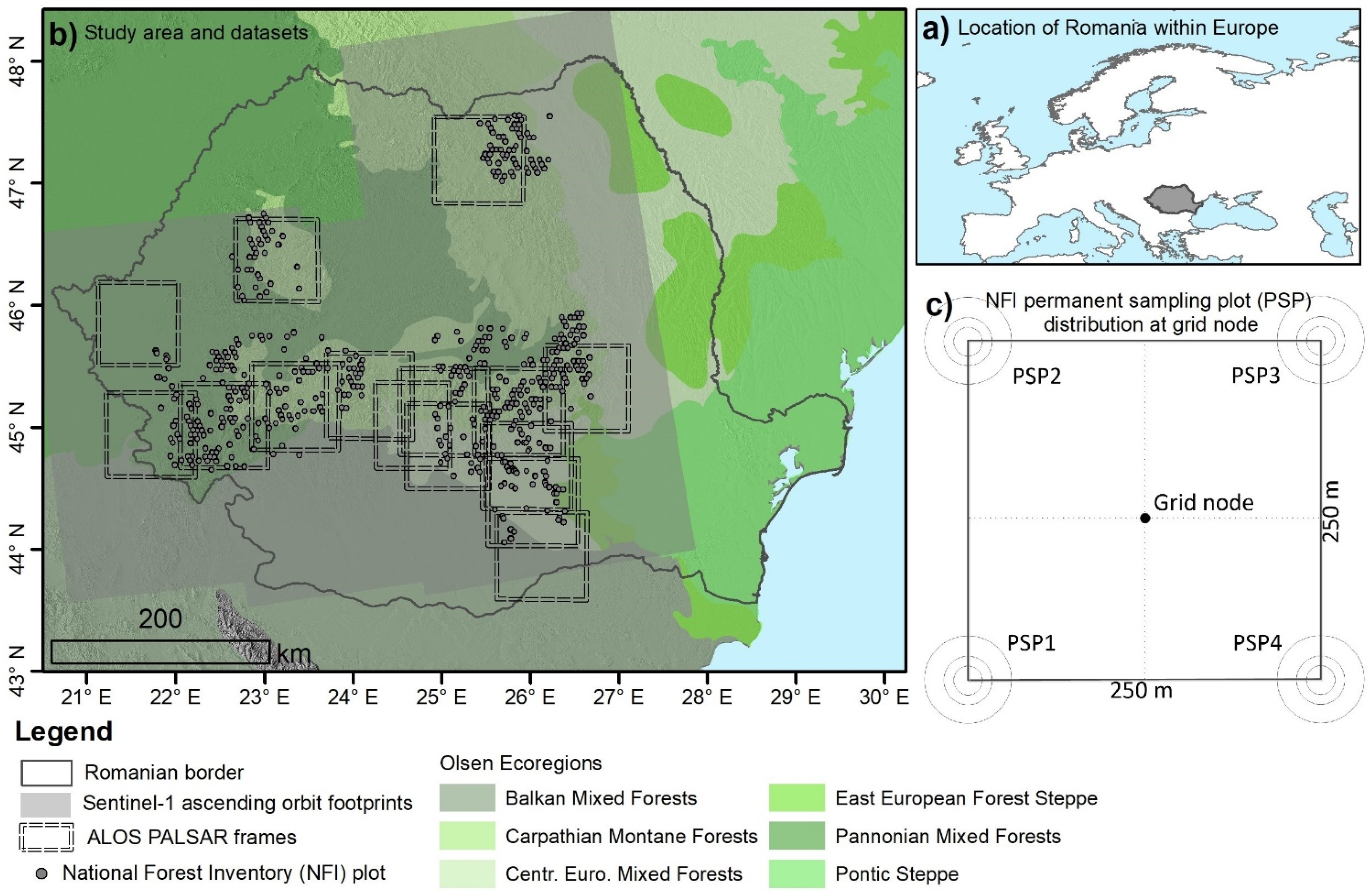

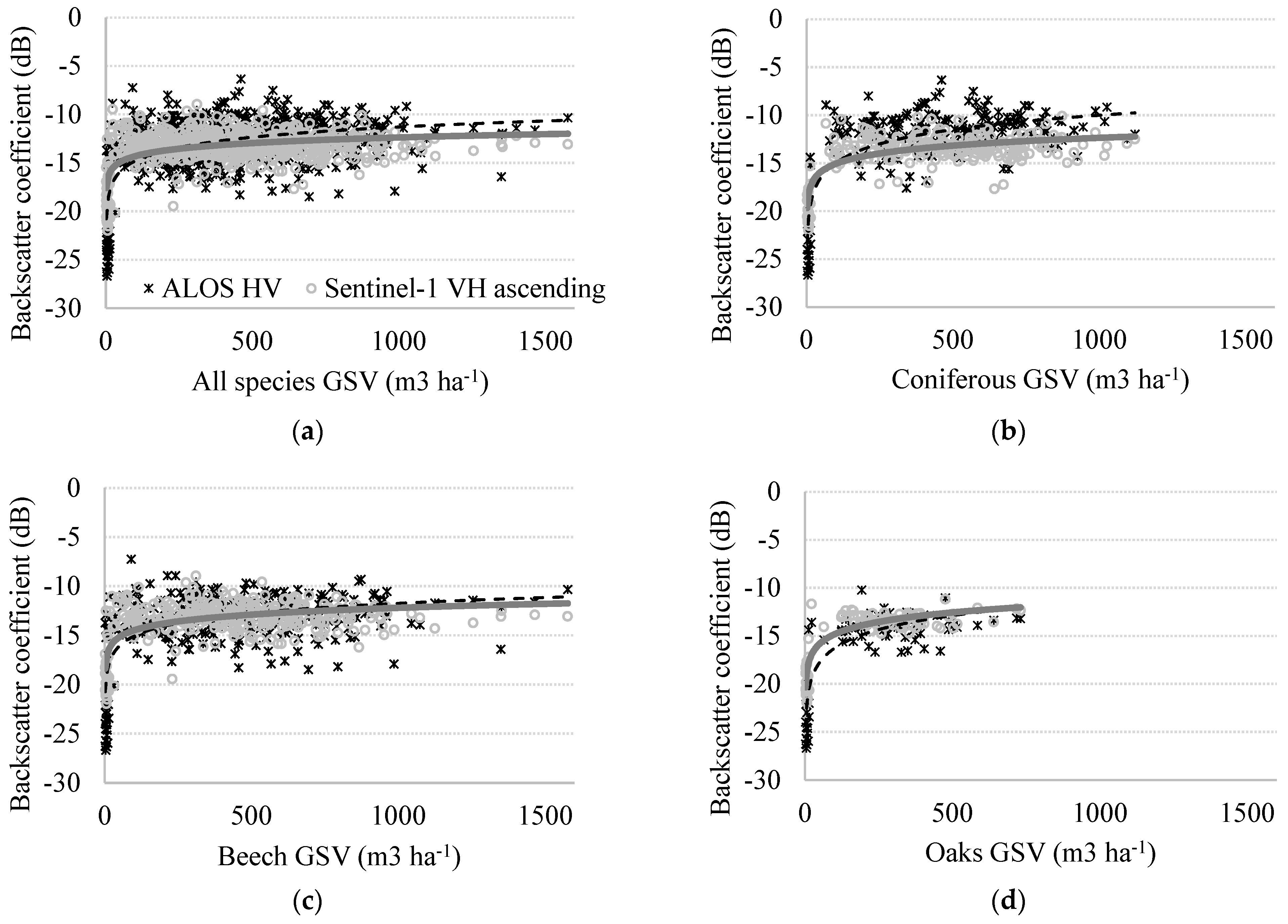
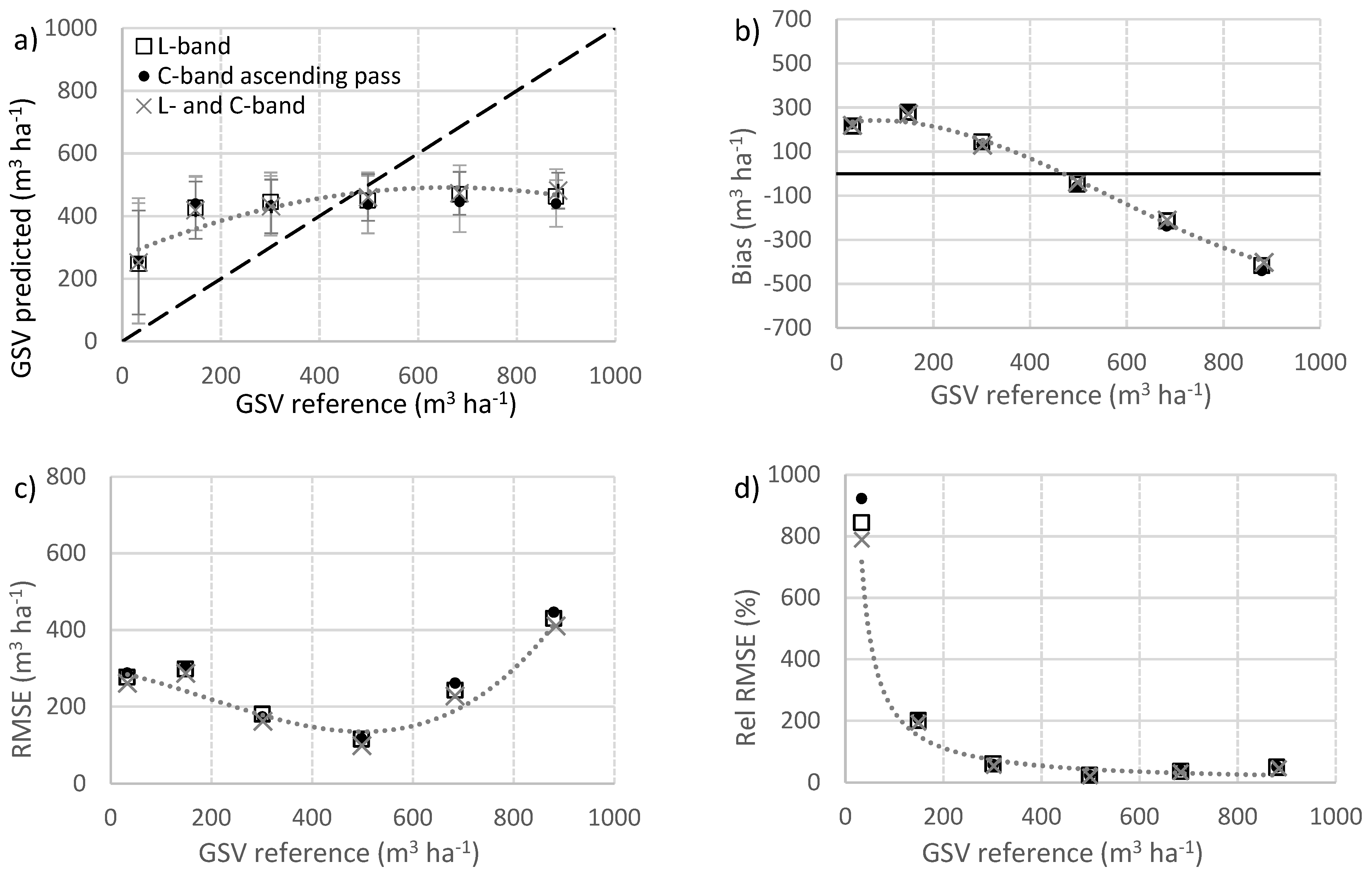
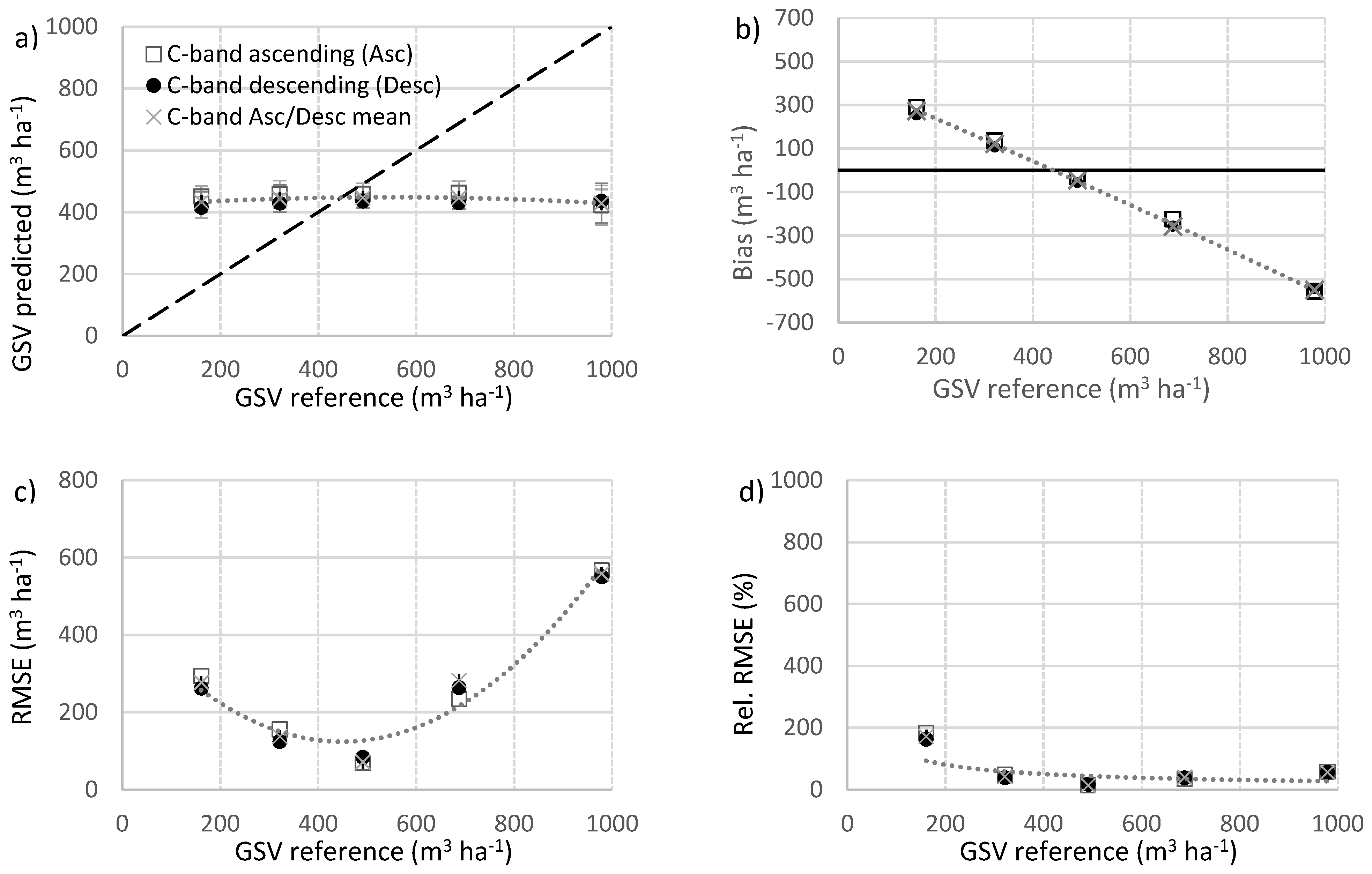
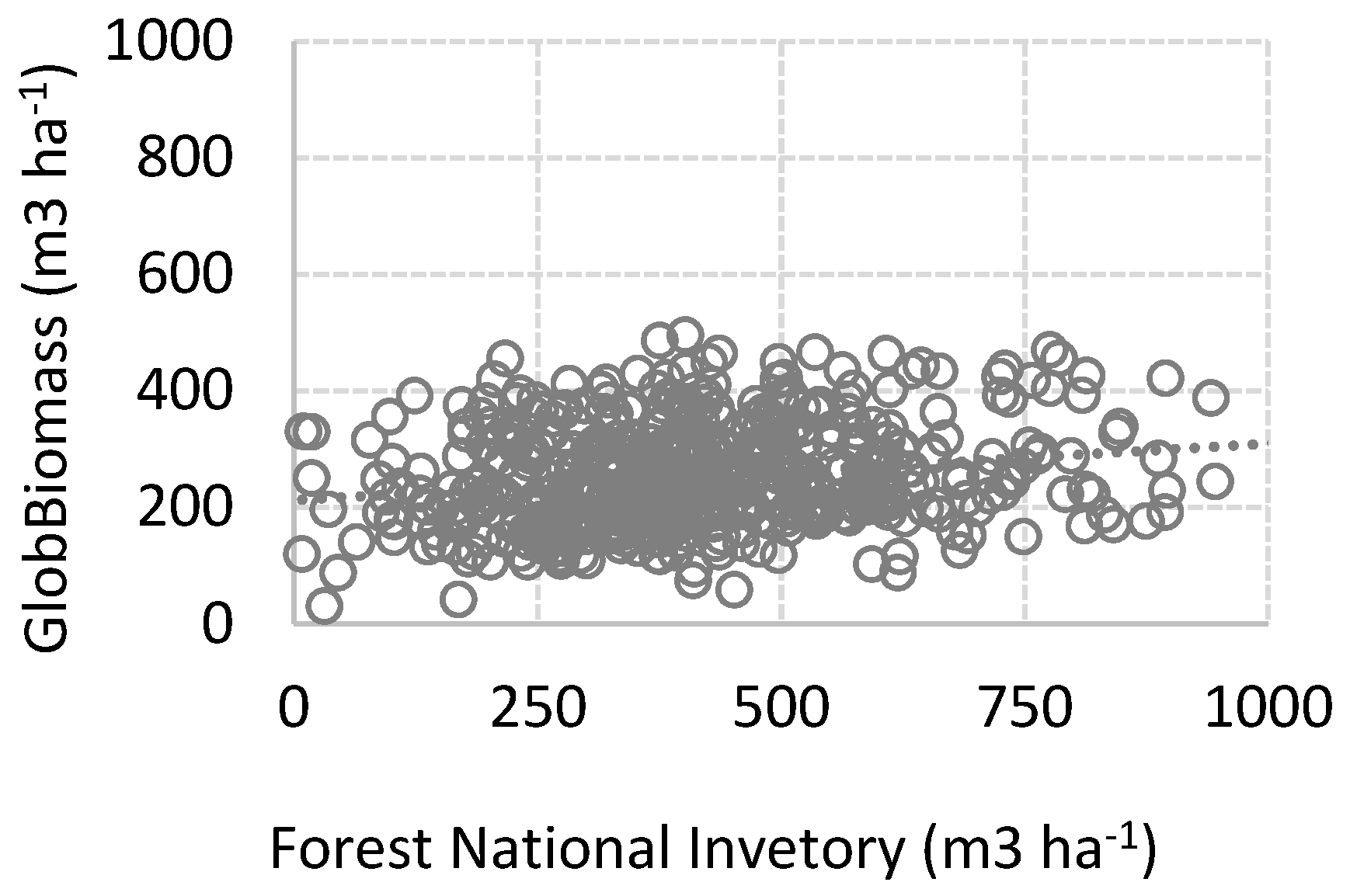
| Main Species | DBH Range (cm) | H Range (m) | GSV Range (m3 ha−1) |
|---|---|---|---|
| beech (n = 900/322) | 7–157/8–96 | 3–50/8–50 | 5–1577/9–1577 |
| oaks (n = 249/72) | 11–80/11–52 | 9–36/11–32 | 13–742/22–731 |
| coniferous (n = 560/238) | 8–85/11–85 | 8–44/9–43 | 12–1470/22–1401 |
| other species (n = 106/33) | 10–66/10–59 | 9–39/12–39 | 15–1080/15–1080 |
| Independent Variables | RMSE | RelRMSE | Bias | r | Independent Variables | RMSE | RelRMSE | Bias | r |
|---|---|---|---|---|---|---|---|---|---|
| L-HV | 266.9 | 62.4 | −1.4 | 0.30 | Ca-VH | 274.0 | 63.9 | −0.3 | 0.24 |
| L-HH | 282.9 | 66.3 | 3.1 | 0.14 | Ca-VV | 275.0 | 63.9 | −2.7 | 0.21 |
| L-HV, L-HVsd | 254.3 | 59.5 | −1.4 | 0.35 | Ca-VH, Ca-VHsd | 263.4 | 62.6 | −0.3 | 0.28 |
| L-HV, L-HH | 253.0 | 58.9 | 0.2 | 0.36 | Ca-VV, Ca-VH | 267.0 | 62.4 | 0.7 | 0.25 |
| L-HV, L-HVsd, Ft | 244.0 | 57.1 | 0.02 | 0.41 | Ca-VH, Ca-VHsd, Ft | 249.0 | 59.2 | 2.1 | 0.38 |
| L-HV, L-HH, L-HH/HV, LIA, Ft | 241.9 | 56.1 | −3.4 | 0.46 | Cd-VV, Cd-VH, Cd-VV/VH, LIA, Ft | 245.7 | 57.0 | −4.6 | 0.41 |
| L-HV, L-HH/HV, Ca-VH, Ca-VV/VH, LIA | 239.9 | 56.2 | 1.9 | 0.45 | Ca-VH, Ca-VHsd, Cd-VH, Cd-VHsd, Ft, LIAa, LIAd | 249.5 | 59.5 | −0.6 | 0.40 |
Publisher’s Note: MDPI stays neutral with regard to jurisdictional claims in published maps and institutional affiliations. |
© 2021 by the authors. Licensee MDPI, Basel, Switzerland. This article is an open access article distributed under the terms and conditions of the Creative Commons Attribution (CC BY) license (https://creativecommons.org/licenses/by/4.0/).
Share and Cite
Tanase, M.A.; Borlaf-Mena, I.; Santoro, M.; Aponte, C.; Marin, G.; Apostol, B.; Badea, O. Growing Stock Volume Retrieval from Single and Multi-Frequency Radar Backscatter. Forests 2021, 12, 944. https://doi.org/10.3390/f12070944
Tanase MA, Borlaf-Mena I, Santoro M, Aponte C, Marin G, Apostol B, Badea O. Growing Stock Volume Retrieval from Single and Multi-Frequency Radar Backscatter. Forests. 2021; 12(7):944. https://doi.org/10.3390/f12070944
Chicago/Turabian StyleTanase, Mihai A., Ignacio Borlaf-Mena, Maurizio Santoro, Cristina Aponte, Gheorghe Marin, Bogdan Apostol, and Ovidiu Badea. 2021. "Growing Stock Volume Retrieval from Single and Multi-Frequency Radar Backscatter" Forests 12, no. 7: 944. https://doi.org/10.3390/f12070944
APA StyleTanase, M. A., Borlaf-Mena, I., Santoro, M., Aponte, C., Marin, G., Apostol, B., & Badea, O. (2021). Growing Stock Volume Retrieval from Single and Multi-Frequency Radar Backscatter. Forests, 12(7), 944. https://doi.org/10.3390/f12070944






